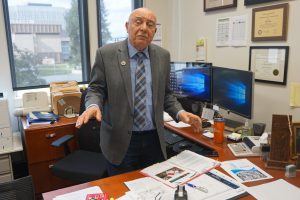
The assessed value of Fresno County real property was up 4.19% for the 2021-22 tax year. Photo illustration by Joe Verduzco.
Across the state in 2018, Proposition 13’s 40th anniversary coincided with funding disputes at Los Angeles, Oakland, Fresno and Central unified school districts.
Passed in 1978, Prop 13 was billed as a way to let “grandma keep her house.”
It unified the tax code between commercial, industrial and residential property, outlining limits on how tax liability was assessed.
As long as a property owner held onto a property, the tax assessment would remain the same, growing at no more than 2 percent a year with regard to inflation.
That tax rate was also determined by its purchase price. So, a home purchased in 1978 California at $70,890 — the median home price according to realestateabc.com — would retain the same assessment value as it would in 2018, so long as ownership remained the same.
Businessman Howard Jarvis’ flagship initiative also froze tax assessments on commercial property. The measure alarmed many local governments and school districts that rely on funding from the tax revenue.
Now, as the bill moves into its 41st year, the Schools and Communities First Initiative (SCFI), a split-roll initiative to reassess certain commercial properties based on market rates, is set to appear on the 2020 ballot. The coalition of social organizations and labor unions endorsing the measure hope the estimated $6.5 – $10.5 billion in additional tax revenue yearly, according to the Legislative Analyst’s Office, would better fund schools and local governments. At the same time, many business leaders and government officials fear it will not only be a daunting task to implement, but also add to property owners’ already full plate of legislative and regulatory hurdles.
If SCFI is approved, the measure details which properties would no longer be included under Prop 13’s tax protections. Property owners whose commercial real estate holdings total more than $2 million and who have more than 50 employees among those businesses would be reevaluated every few years — to be determined by legislators — under a market rate, according to Veronica Carrizales, policy director for California Calls, one of the SCFI committee organizations.
This excludes residential and agricultural properties. Other exceptions include hotels that provide long-term housing.
The goal is to impact small business as little as possible, Carrizales said.
Of the $7-$10 billion in additional revenue, 80 percent of it would come from 8 percent of commercial and industrial property owners, according to a 2018 study from the University of Southern California.
“We are seeing these are large corporations who have made billions of dollars in profit,” Carrizales said.
One of those examples Carrizales cites is GAP, which owns a warehouse on 8.6 million square feet of land near the Fresno Yosemite International Airport. Due to its ownership structure, it has avoided re-assessment. Her office found it is paying $1.47 per square foot where some assessments put market rate at $10-$17. Resulting revenue for Fresno County would be an additional $900,000 to $1.5 million, Carrizales said.

Generated revenues would bypass the general fund, according to ballotpedia.org. “After paying for county administrative costs and backfilling state income tax losses related to the measure, the remaining $6 billion to $10 billion would be allocated to schools (40 percent) and other local governments (60 percent),” the website reads.
State income tax losses would be due to both personal income and business taxes.
It’s the county administrative costs that worry Paul Dictos, Fresno County assessor-recorder.
According to the LAO, administrative costs would run around $500 million yearly.
Speaking to assessor’s offices in Los Angeles County, Dictos said they have already begun hiring 500 new assessors in anticipation of the measure passing. The L.A. County Assessor’s Office could not be reached to verify these claims.
Finding the staff to reevaluate the 290,000 parcels in Fresno County would be a “nightmare,” said Dictos, who estimates a need for between 31 and 45 new assessors. Training a new assessor also takes four to five years, Dictos said, considering the new way properties would have to be assessed.
Estimated cost to fill 31 positions would run Fresno County between $3 and $4 million that the county “does not currently have,” according to Jordan Scott, spokesman for Fresno County.
The County Assessor’s Association puts the need at 900 new assessors statewide.
In Fresno County, there are around 2,200 parcels valued at more than $2 million, but that doesn’t include the businesses whose owner has commercial properties totaling more than $2 million and 50 employees.
Determining market rate also requires a subjective measure.
“Because we know it’s probably going to result in appeals, every time we have an appeal, it’s almost like doing a fee appraisal,” said JoAnn Ebisuda, Fresno County assistant assessor. “We go and we look at the cost approach, market approach, income approach and we have to look at every parcel that has an appeal.”
Delays in reassessments could mean less revenue for counties and business owners having to wait to find out property values and tax liability.
Jonathan Feld, CEO of Sportsmobile in Fresno, feels Prop 13 reform would be “another money grab by the state.”
“It slows growth and development,” Feld said. “Where we’d want to take this money and invest in more employees, more equipment, technology, maybe buying another building, all these things, it’s going to affect all of that.”
Feld’s business in south Fresno outfitting vans as recreational vehicles has been running at maximum capacity for the past few years. It lies right on the cusp of the $2 million threshold, he said.
It hasn’t been assessed since its purchase in 2000.
Jean Rousseau, county administrative office for Fresno County, sees SCFI in two different lights. As CAO, additional revenues mean the county can address capital improvement needs and increase salaries to attract qualified job applicants, much like what would be needed at the assessor’s office.
At the same time, under his role on the executive committee of the Fresno County Economic Development Corp. board of directors, he worries about the business climate.
A 2014 study by Andrew Chang & Co., LLC ranked California as 49th, 47th, 48th and 41st for cost of taxes, litigation, energy and labor, respectively. And at the time since, considering minimum wage laws, recent labor laws and mandated green energy initiatives passed since then, Rousseau said those numbers “would not have gone down.”
In attracting business, he added, Prop 13 provided business owners with a level of predictability in property values.
“Businesses know that they can plan and have some level of certainty that their property taxes aren’t going to increase more than 2 percent,” Rousseau said.








